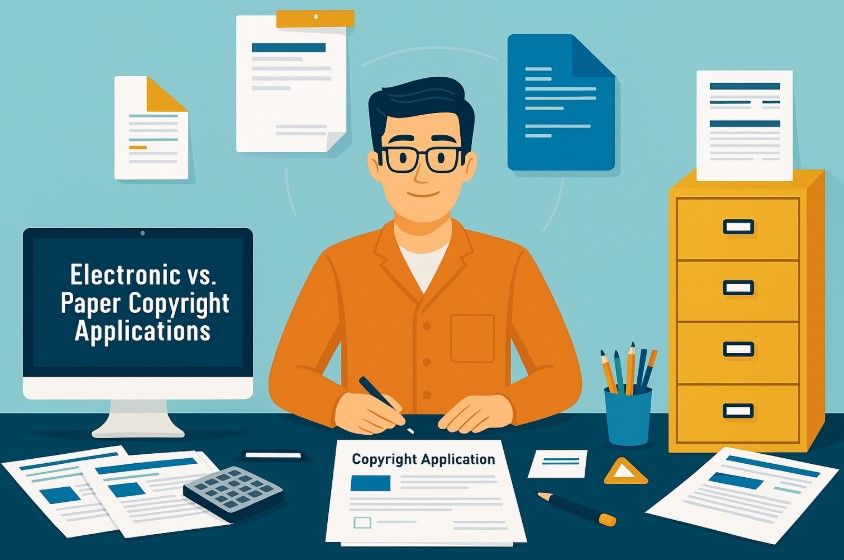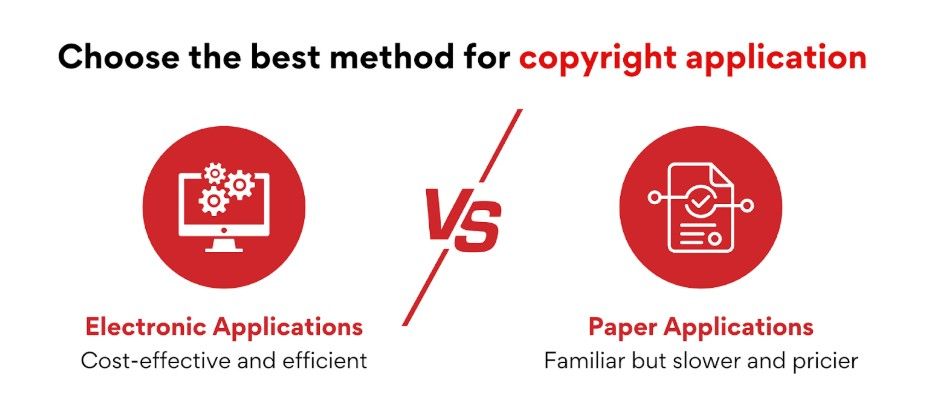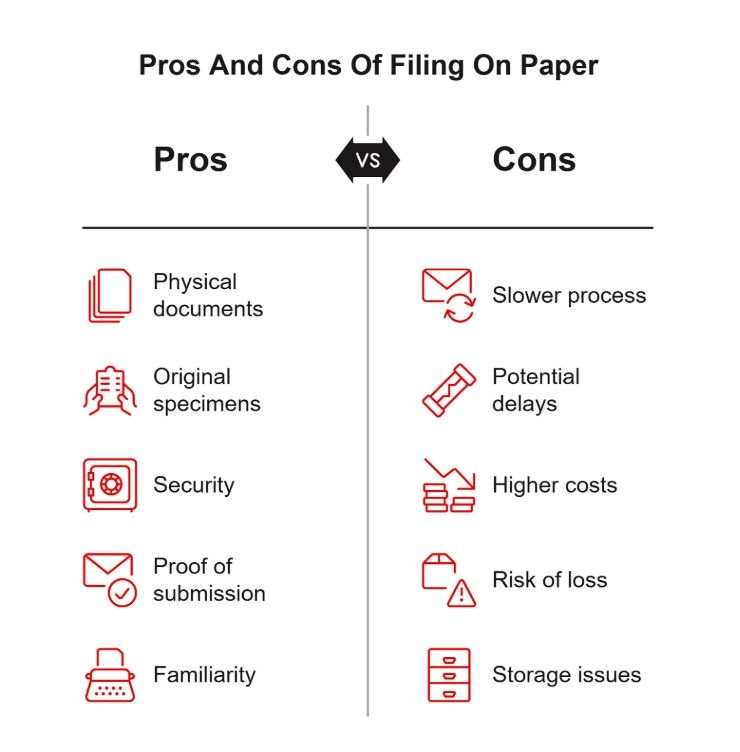

When protecting creative work, artists and businesses face a big decision: how to file a copyright application.
Choosing between electronic and paper copyright applications affects how quickly, easily, and affordably a work gets registered.
Is one method better, or does it depend on what feels right for you? That’s a pretty common question.
Online filing is usually faster and less expensive. Paper applications take longer and often cost more in fees.
Most people now file electronically using systems like the eCO registration tool. Still, some choose paper for their own reasons.
According to the U.S. Copyright Office 2023 Annual Reportin FY 2023, 96% of copyright applications were filed electronically via the eCO system, according to the U.S. Copyright Office 2023 Annual Report.
Understanding these differences can help you avoid delays and get legal protection sooner.

Choosing how to file a copyright has a big impact. The option you pick affects speed, price, and how quickly your work is protected.
Electronic filing is much quicker. Online applications are usually processed faster, so creators can secure protection earlier.
Paper filings can take several months to complete because they need to be mailed and reviewed by hand.
Online filing is also typically cheaper. Digital applications have lower fees, which helps with budgeting.
Paper submissions cost more since there’s extra handling and sometimes higher fees.
| Filing Method | Average Fee | Processing Speed |
| Electronic | Lower | Faster |
| Paper | Higher | Slower |
Registering sooner really matters if you need to enforce your rights. Filing electronically lets you be legally ready faster in case someone copies or misuses your work.
Having immediate access to an electronic record is also handy if you need to prove registration.
The U.S. Copyright Office allows people to submit copyright applications electronically or on paper. Each method has its rules and perks; sometimes, one just makes more sense than the other.
You’ll use the eCO system to file electronically. This site walks you through submitting copyright applications, registering a work, and uploading files.
You can use it for books, music, software, art—pretty much anything. First, you’ll need to make a free eCO account. The system has clear forms, like the “Single Application” for just one author and one work, or the “Standard Application” for almost everything else.
Credit card, debit card, or electronic funds transfer payments are handled online. After you submit your application, you can track its status online, which is a huge relief.
The eCO system is the fastest choice. Most applications get reviewed and processed way quicker than paper filings.
If you want to go old-school, you can submit on paper with Form CO. Download the blank form from the Copyright Office website and print it out.
Fill it in by hand or type it, and follow the instructions closely—mistakes can slow things down. Mail the completed form, a check or money order, and a physical copy of your work to the Copyright Office.
Unlike e-filing, you can’t track status online, and processing takes longer. Paper forms work best for large or unusual works, or if you prefer paper records.
Paper applications are still allowed in 2025, but expect higher fees and slow processing. Electronic filing is encouraged, but you can mail it in if you need to.
Filing for the first time? Ana Law simplifies your copyright application—electronic or paper—so you don’t risk delays or denials. Schedule your copyright strategy call today.
If you’re ready to get started, call us now!

You’ll notice clear cost, speed, and user experience differences between online and paper filing. Some options save you time and money, while others just feel more familiar.
Electronic copyright applications usually cost less. As of 2025, filing online with the U.S. Copyright Office’s system starts around $45 for many works, though it depends on the type and number of works.
Paper applications, though, have higher fees—sometimes over $125 per submission. That’s partly because paper applications need more manual work from government staff.
Fee differences really add up if you’re registering a bunch of works. For most people, online applications are the budget pick, especially for single workers or small batches.
Electronic applications move through the system much faster. Digital filings are often reviewed in a few months, and you’ll get your copyright certificate by email as soon as it’s done.
Paper applications take longer since the staff handles everything by hand. It’s not unusual for them to take six months or more, and certificates arrive by mail. Electronic filing is the way to go if you want fast proof of registration.
Online systems also help you catch mistakes immediately, saving you from annoying rejections.
Filing electronically is just easier for most folks. The online system guides you step by step, gives instant feedback, and lets you fix errors before you submit.
You can track your application and make changes if you need to. With paper, you’ve got to print, mail, and then wait. If you mess up, you’ll get a rejection letter—not fun.
Some people still like paper forms for personal reasons or accessibility, and that’s fair. Security is a concern, too. Electronic registration systems use encryption and secure logins, so they’re generally safe to use.
Paper filings aren’t at risk from hackers, but there’s always the chance of mail getting lost or damaged. Both methods have their risks, but for most, electronic is easier and more reliable.

Filing a copyright application online can save time and reduce errors. Still, there are a few risks and drawbacks you should think about before picking a method.
Electronic filing is usually much faster than mailing paper documents. Processing times are shorter; you can check your application status online anytime.
The ability to track your status online makes the whole process less stressful. Online filing can also cost less, since government fees are often lower.
The system helps you avoid common mistakes by checking forms before you submit them. So, you won’t have to worry about bad handwriting or missing information.
Convenience is a huge plus. You can file twenty-four hours a day from anywhere with internet access. Digital records are stored electronically, so it’s easier to find old documents if needed later.
Filing electronically does raise privacy concerns. You’re required to provide personal details—full name, address, even your Social Security number—so you’re trusting the internet with sensitive information.
If cyber attackers target the site or your computer, that data could be at risk. Technical glitches, like site outages or software bugs, can also slow things down.
Not everyone is comfortable with online systems, and digital forms can be confusing. Uploading files can be tricky if your work is large or in an odd format.

Filing a copyright application on paper has its ups and downs, depending on what you care about. Security, simplicity, and how you handle documents all come into play.
Paper filing gives you physical documents you can keep as hard copies. Some people find these easier to track and organize over time.
This method lets you include original or tangible copyright specimens, which might be important if your work doesn’t translate well to digital.
Since paper documents aren’t online, there’s less risk of data breaches or hacking. Experts note that paper filing might have fewer security risks compared to digital methods.
Mailing a copyright specimen makes it easy to prove what you submitted, which can help if there’s ever a dispute.
Many just find paper forms more familiar—there is no new tech to learn and no computer errors to worry about.
Paper filing is usually slower. You have to mail documents, and someone at the copyright office processes them by hand.
Delays can occur if forms are lost or need corrections. You may have to wait even longer before your copyright is registered.
Electronic applications move faster since you submit and review everything online. That online process just skips a lot of the old-fashioned hassle.
Paper filing brings extra costs, too. You’ll pay higher government fees, plus postage and printing.
Mailing a copyright specimen means physical items could get lost or damaged in transit. You can’t track a paper application step by step, so updates take longer.
Many people find storing paper records a headache. Digital files are easy to back up and search, but paper needs physical space and can be lost to fire or water damage.
If you’re a busy creator, all that makes paper filing less convenient than just clicking through an online form.
Need protection fast? Ana Law helps creators and businesses choose the fastest, most accurate filing method for their needs. Book a consultation to file confidently.
If you’re ready to get started, call us now!
Choosing between electronic and paper copyright applications really comes down to time, convenience, and your specific needs.
Sometimes you just want the fastest, easiest route, but it still calls for paper in other cases.
Filing a copyright online through the eCO system is usually the quickest way to do so in 2025. Most people finish up faster and can track their applications right from the computer.
Electronic filing works best for:
You can upload your deposit (your copy of the work) on the site. Online applications usually cost less than paper ones, and you can fix mistakes before you send everything in.
The eCO portal stays open 24/7 and walks you through the steps. Most digital art, music, books, and creative works fit this process. If you get stuck, there’s direct support on the site.
Sometimes, paper filing just makes more sense—especially for older works or unusual situations. Maybe you don’t have digital access, or the work needs to be sent physically.
Some applicants must use paper, like those submitting certain published collections or work types that the online system doesn’t support. Really complicated ownership might also be easier to explain on paper forms.
Libraries, estates, or organizations that want paper records might stick with this method. You can mail big, non-digital works along with your application, too.
Processing takes longer, and fees are usually higher, but paper filing still works for special cases.
Some parts of the filing process change depending on your method. You’ll want to know about file formats, payment steps, and how to handle tech hiccups or paperwork snags.
If you use the Electronic Copyright Office (eCO) system, create an online account with your real info. Only certain file types—like PDF, JPEG, or MP3—are allowed depending on your work.
File size limits exist, so you may need to compress big files. If your file type isn’t accepted, just run it through a conversion tool before uploading.
You can pay fees online with a credit card, debit card, ACH, or Pay.gov. Please make sure you finish the payment before clicking ahead.
If you encounter login or upload errors, try clearing your browser cache or switching browsers. Tech issues happen—check the eCO registration tool guide or contact support if you’re stuck.
Save all your submission receipts and registration confirmations. You’ll want those for your records, just in case.
If you choose a paper application, fill out the forms clearly using blue or black ink. Messy handwriting could delay or even cause your forms to be sent back.
Please make sure you include all three required items: the application, a physical copy of your work, and the correct filing fee.
Usually, you can pay by check or money order. Double-check the paper filing requirements before mailing anything.
Send your documents to the official U.S. Copyright Office address. Use a trackable shipping method.
Always photocopy everything you send for your own records. Missing pieces or mistakes can slow things down or lead to rejection.
Electronic and paper copyright applications both get you the same legal protection under U.S. law.
The way you file just affects how fast you get that protection and how smoothly you can start legal actions if needed.
The U.S. Copyright Office gives you identical legal protection whether you file electronically or on paper. What matters is a complete application, the right fee, and a copy of your work.
Your legal rights kick in as soon as the work is tangible, but registration brings extra perks.
You can file lawsuits, claim damages, or pursue attorney’s fees. Once approved, either filing method unlocks those rights.
So, picking electronic or paper is about speed and convenience, not different legal results.
Registration speed matters if you want to enforce your rights quickly. Electronic filings get processed way faster—often in a few months instead of a year or more.
You might have to wait to start a lawsuit if someone infringes before you’re registered. Paper applications take longer because of mailing and manual review, so you can’t move as fast. Going digital lets you get into court sooner if you need to.
Which method is right for your work? Ana Law provides personalized guidance to ensure your copyright application is filed correctly and on time. Contact us now to get started.
What is the difference between electronic and paper copyright applications?
Electronic applications are submitted through the U.S. Copyright Office’s eCO system, while paper applications are mailed using Form CO. Both provide legal protection but differ in speed, cost, and convenience.
Which is faster: electronic or paper copyright registration?
Electronic copyright applications are typically processed within 3–12 months. Paper applications often take longer, sometimes over a year, due to manual handling and postal delays.
What’s the cost of electronic vs. paper copyright filing in 2025?
As of 2025, electronic filings cost $45–$65, while paper applications using Form CO cost $125.
Can I file all types of work electronically?
Yes, most work types—including software, music, literature, and visual art—can be registered electronically. Complex or multi-author works may require special filing categories.
Do I need to mail anything for an electronic copyright application?
No. With the eCO system, all required documents and specimens are uploaded online—nothing needs to be mailed unless requested by the Office for supplemental review.
Is one filing method more secure than the other?
Both methods are secure. However, electronic filing offers digital tracking and confirmation, reducing the risk of lost documents compared to mailing paper forms.
When should I choose paper filing over electronic?
Use paper filing if you need a physical record for archival reasons, are filing internationally where hard copies are preferred, or the work type isn’t supported online.
Across the country and around the globe, business leaders and innovators look to Ana Law as their trusted legal advisor for excellence, innovation, and superior results.
As you look for opportunities to expand and grow your business and revenue, Ana Law is here to help every step of the way. We provide actionable legal & business advice to protect your ideas, products, brands, and revenue.
© Copyright 2025, Ana Law LLC. All Rights Reserved. Privacy Policy | Terms of Use